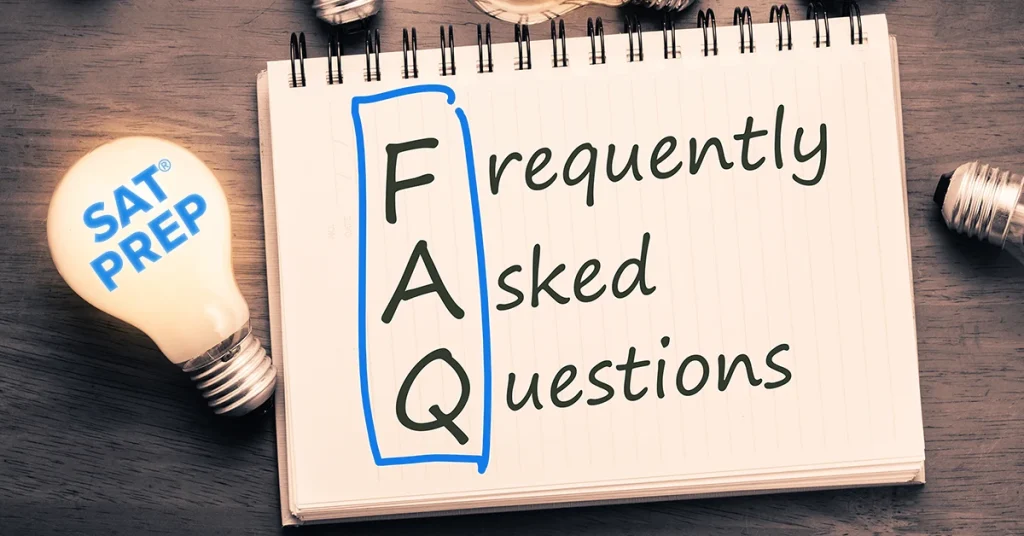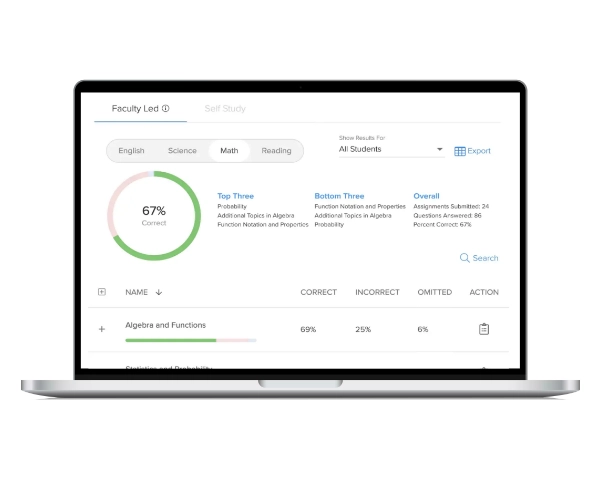Here at UWorld, we want to support all of the SAT® teachers who are working so diligently to prepare their students for the upcoming digital SAT exam. That’s why we’ve put together these FAQs based on the input and experiences of our in-house exam experts and SAT tutors at UWorld. This frequently asked questions guide will provide you with valuable insights to support your students with their preparation. We’ve got you covered with everything from online resources and pacing strategies to learning how to tackle both sections of the digital SAT (reading and writing, and math), along with several last-minute preparation tips.
Digital SAT FAQs: What SAT Teachers Want to Know About Digital Exam Prep

What’s the role of online resources in digital SAT preparation, and how should students incorporate them into their study routine?
Online resources are super helpful for digital SAT prep. They give students a flexible way to improve their skills. These resources offer practice materials, tests, and expert guidance, so students can study how and when they want. UWorld is one of these helpful resources. UWorld provides a variety of expert-curated SAT practice questions and tests that look just like the real digital exam. Each question is complete with an answer explanation for not only why answers are correct, but also why other answers are incorrect.
SAT teachers can implement UWorld into their digital exam prep by including it in tutorial sessions or suggesting it as extra practice. With UWorld, students get a taste of what the digital SAT is really like. It helps them understand why some answers are better than others. Teachers can also use it to track how students are doing, see where they need more help, and give them targeted practice.
How can students effectively pace themselves through each section of the digital SAT to avoid running out of time?
When helping students with digital SAT time management, SAT teachers can share clever strategies for both sections of the test.
When doing the digital SAT’s reading and writing section, students have to answer 54 questions across two modules in 64 minutes. The digital SAT verbal section introduces a unique format featuring short reading passages or passage pairs, each accompanied by a single multiple-choice question. Questions are thoughtfully organized into four content domains—Craft and Structure, Information and Ideas, Standard English Conventions, and Expression of Ideas—grouping them by similar skills and knowledge levels. Consisting of two modules, the reading and writing section includes questions from all four domains in each module.
The short passages, spanning 25 to 150 words, cover a variety of subject areas such as literature, history/social studies, the humanities, and science. Reading and writing questions test comprehension, analysis, reasoning, vocabulary, and rhetorical skills. Overall, this section of the digital SAT strategically challenges students across various skills, engaging them with diverse content and question formats to assess their language arts proficiency.
When helping students with the SAT math section, remember it covers various math topics like algebra, geometry, and more. There are 44 questions in total and students have 70 minutes–with full-access to a calculator–to answer all of them. One helpful strategy is for students to spend about a minute on each question–we call that the “first pass.” Start with the easier questions and save the tough ones for later. If a question seems extra hard and time-consuming, students can mark it on their digital test and move on. This way, they can manage their time better and increase their chances of answering all the questions.
What’s the most efficient way to approach the SAT reading and writing section?
To prepare students for the reading and writing section of the digital SAT, teachers should emphasize a strategic and confident approach. Teach students the importance of eliminating wrong answers systematically, speeding up their decision-making process. Encourage students to predict the correct answer to a question before they read through each answer choice, making it easier to recognize the correct answer choice when they see it. Caution students against hastily choosing a “No Change” answer unless they’re absolutely sure it’s correct, and promote a thorough review of completed sections to catch any overlooked errors. Last (but not least), students should remember to never, ever skip a question. Even if they plan to come back to it, they should take a guess and mark it for later. Remember, students won’t lose points for guessing.
What are the best strategies for tackling the SAT math section, particularly for the more complex problem-solving questions?
One of the first things SAT teachers should encourage their students to do is learn the 12 important formulas that are used–and provided–in the SAT. Memorizing these is a simple way to help students save time during the exam because they won’t have to keep flipping to the front of their test to view the formulas.
Practice resources are a must. Good ones, like UWorld’s Online Preparation for the ACT & SAT Exams, are helpful because not only do the questions mimic those on the real SAT test, but each answer to a question comes with detailed explanations to help students build their understanding. When they make mistakes, SAT teachers can encourage students to think of it like learning from a game. Instead of getting frustrated, they can look at the questions they get wrong and take on the exciting challenge of figuring out why.
Students should also learn to annotate and underline important information in the questions. This helps them stay focused on what each question is really asking. Also, remind students to manage their time. Timed practice tests can help them develop pacing skills for the exam, as well. After all, students shouldn’t spend too long on one question; they need to keep moving.

What’s the best approach to utilizing the process of elimination for SAT multiple-choice questions?
Teachers can help their students effectively tackle the SAT math section, particularly the more complex problem-solving questions, through strategic preparation and targeted strategies. Emphasize the importance of consistent and focused practice, relying on both practice tests and specific exercises to increase familiarity with the tested concepts. After practice tests, encourage students to conduct a thorough review, identifying strong and weak areas.
For the more complex questions, help students learn how to pace themselves while taking the exam, aiming for about a minute and a half per question. Teach students to “flag” challenging questions and return to them if time permits. Students can leverage answer choices when feeling stuck, using them as problem-solving clues. Additionally, teach your students to rely on the process of elimination strategy, encouraging them to discard options that are clearly wrong.
What’s the role of vocabulary in SAT preparation, and how can students build a strong vocabulary?
Vocabulary plays a role in digital SAT preparation, but students don’t need to memorize lots of strange words. The digital SAT mostly uses words from college or professional settings, and often, you can figure out their meanings from context clues. So, it’s important to teach students how to recognize these clues within a text to understand new words.
However, spending some time on vocabulary is still a good idea, especially if spending time on words commonly found in college-level materials. This helps students recognize words quickly, making them read faster and with more confidence.
To boost your students’ vocabulary and their ability to understand words in context, you can use digital SAT prep resources like UWorld’s Online Preparation for the Digital & SAT Exam. These tools provide practice questions paired with short reading passages that can help students build a stronger vocabulary and prepare effectively for the digital SAT.
What should students do in the final week leading up to the digital SAT to maximize their performance?
In the week leading up to the digital SAT, students should focus on a few important things to be fully prepared:
- Practice Regularly: Keep practicing digital SAT-style questions and take timed tests. This builds confidence and sharpens test-taking skills.
- Review Tough Topics: Spend time revisiting challenging topics and questions encountered during preparation. This can improve performance.
- Rest and Focus on Nutrition: Remind students to get adequate sleep, especially the night before the digital SAT. Eating balanced meals keeps their minds alert.
UWorld can be especially beneficial during this week. This is because UWorld offers digital SAT practice questions resembling those seen on the real exam. It helps students assess their DSAT readiness. Teachers can assign practice tests or specific questions to address weak areas, and UWorld provides detailed explanations for learning from mistakes. Teachers can track students’ progress and identify areas needing more attention.
On the day before the digital SAT, students should relax and avoid cramming. A brief review of important strategies and formulas can be useful, but students shouldn’t do very much studying beyond that. Students should make sure all necessary materials, like IDs and admission tickets, are organized. Most importantly, students should get a good night’s sleep for peak performance.
What are the most common traps and pitfalls that students should be aware of when taking the digital SAT?
To do well on the SAT, students need to watch out for some of the most common traps and pitfalls:
- Time Management: Managing time poorly can lead to unfinished questions and rushed decisions. Students should practice with timed tests to get better at this and reduce stress on test day.
- Misreading: Careless reading can lead to mistakes. It’s crucial for students to actively read and, if they catch themselves forgetting what they just read, going back and re-reading that section.
- Use Annotation Tools: Remind students to use the digital SAT’s annotation tools to mark questions, underline, make note of important information, etc.
- Don’t Leave Blanks: Students should never leave answers blank. Even if students aren’t sure about an answer, guessing is better because there’s no penalty for wrong answers.
- Review: If there’s spare time at the end of a section, students should use it to review their answers and make sure they haven’t left anything blank.
Starting digital SAT prep early, relying on online resources, and seeking help when needed are also important. Avoiding these pitfalls and preparing well through practice and understanding core concepts can lead to better digital SAT scores and test-day success.
What’s the significance of the digital SAT score range, and how can students set realistic score goals?
The total digital SAT score ranges from 400 to 1600. The two main sections, reading and writing and math, each go from 200 to 800. To set realistic score goals, students need to understand this score range.
Here’s how students can set good goals: They should look at the middle 50% SAT scores of the colleges they want to go to. This shows the scores of the students from the middle who got in. Then, they should find the highest score in the 75th percentile for their dream schools. This is the goal score for those colleges.

Key Takeaways
As digital SAT tutors and teachers, we know you have a challenging job helping your students do well on the exam. We, at UWorld, hope these digital SAT FAQs and their answers provide you with useful information and strategies to share with your students so they can reach their digital SAT goals.
Find out how using UWorld’s Online Preparation for the ACT & SAT Exams can help you get your students ready for the digital SAT.

References
- Managing your time on the SAT or ACT. Get Schooled. (2023, April 11). https://getschooled.com/article/4901-managing-your-time-on-the-sat-or-act/#:~:text=Give%20yourself%20eight%20minutes%20per,with%20five%20minutes%20to%20spare.&text=This%20means%2C%20read%20the%201st,answer%20in%20the%20passage%2C%20etc.
- Admin. (2023, January 13). 5 Must-Know SAT Reading Tips. Kaplan Test Prep. https://www.kaptest.com/study/sat/5-must-know-sat-reading-tips/
- Sarikas, C. (2019, December 31). The 16 best sat math tips and tricks. The 16 Best SAT Math Tips and Tricks. https://blog.prepscholar.com/sat-math-tricks
- Sorensen, T. (2022, March 28). The optional sat essay: What to know – U.S. news & world report. U.S. News & World Report.https://www.usnews.com/education/blogs/college-admissions-playbook/articles/what-to-know-about-the-optional-sat-essay
- Christian, & Name. (2017, January 20). A pro tutor explains how to eliminate on the SAT & Act Tests (for perfect scores!). Love the SAT Test Prep. https://www.lovethesat.com/elimination-on-the-sat-and-act-tests#:~:text=If%20you%20just%20eliminate%20an,each%20answer%20choice%20you%20eliminate.
- College Board. (2023). Sat Vocabulary. SAT Suite. https://satsuite.collegeboard.org/sat/whats-on-the-test/reading/sat-vocabulary#:~:text=All%20of%20the%20words%20you,often%20in%20college%2Dlevel%20assignments.
- Wignall, A. (2022a, December 22). Common Mistakes Students Make on the ACT/SAT. College Raptor Blog. https://www.collegeraptor.com/getting-in/articles/act-sat/common-mistakes-students-make-act-sat/
- Muniz, H. (2023, April 19). SAT Score Range: 3 Steps to Understanding Your Score. PrepScholar. https://blog.prepscholar.com/sat-score-range




